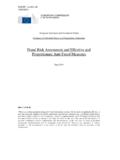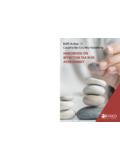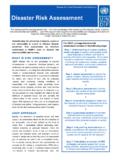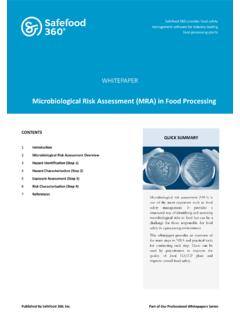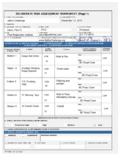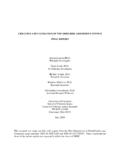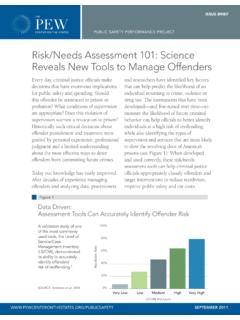Transcription of Disaster Risk Assessment and Risk Financing - …
1 Disaster Risk Assessment and Risk FinancingA G20 / OECD METHODOLOGICAL FRAMEWORK TABLE OF CONTENTS INTRODUCTION .. 9 SECTION I RISK Assessment .. 15 1. GOVERNANCE .. 17 a) Scope, objectives, definitions and methodology .. 17 b) Transparency and accountability .. 19 c) Multi-level governance, multi-actor participation .. 20 2. RISK ANALYSIS .. 25 a) Hazard identification and analysis .. 26 b) Vulnerability and impact 28 c) Risk 37 d) Risk monitoring .. 40 3. RISK COMMUNICATION AND AWARENESS .. 41 a) Internal and external communication .. 41 b) Public awareness strategies .. 41 c) Tools for interpreting risk analysis .. 42 4. POST- Disaster IMPACT ANALYSIS .. 45 a) Impact Assessment .. 45 b) Quantification .. 46 5. POLICY IMPLICATIONS OF RISK Assessment OUTCOMES .. 47 SECTION II RISK Financing .. 49 1. FINANCIAL EXPOSURE AND CAPACITY .. 52 a) Risk exposure .. 52 b) Risk-bearing capacity .. 53 2. RISK Financing AND TRANSFER .. 57 3. INSTITUTIONAL ARRANGEMENTS.
2 65 CONCLUDING REMARKS .. 85 ANNEXES .. 87 I SELF- Assessment GUIDING TOOL .. 88 II TERMINOLOGY .. 94 Background and main policy messages Mandate G20 Finance Ministers and Central Bank Governors along with G20 Leaders have recognised the importance and priority of Disaster risk management (DRM) strategies and, in particular, Disaster risk Assessment and risk Financing . They invited the OECD to develop a voluntary framework that could strengthen these two key components of DRM and complement a compilation of country experiences published by the Government of Mexico and the World Bank: We recognize the value of Disaster Risk Management (DRM) tools and strategies to better prevent disasters, protect populations and assets, and financially manage their economic impacts. We appreciate World Bank and OECD combined efforts, with the UN s support, to provide inputs and broaden participation in the discussion on DRM. We welcome the World Bank s and Mexico s joint publication on country experiences in this area with the support of G20 members, and the OECD voluntary framework to facilitate implementation of DRM strategies, to be completed by November.
3 (G20 Leaders, Los Cabos, June 2012) A voluntary methodological framework has been developed that will provide a useful tool for Finance Ministries and other relevant stakeholders involved in DRM. This framework focuses on Disaster risk Assessment and risk Financing and their interlinkages, acknowledging that risk Assessment is also essential for other components of DRM. The framework is intended to complement and build on existing international frameworks for DRM and promote more effective and sustainable DRM strategies. It is completed by a self- Assessment guiding tool. Context It is recognised that disasters can have widespread impacts, causing not only harm and damage to lives, buildings and infrastructure, but also impairing economic activity, with potential cascading and global effects. These impacts generate losses for households, businesses and governments as damages need to be repaired, homes and businesses rebuilt, and activities resumed.
4 These financial costs may be catastrophic in nature, aggravating economic and social impacts. Achieving financial resilience is thus a critical component of effective DRM. Financial strategies for DRM are intended to ensure that individuals, businesses and governments have the resources necessary to manage the adverse financial and economic consequences of disasters, thereby enabling the critical funding of Disaster response, recovery and reconstruction. These strategies depend on a comprehensive identification and accurate evaluation of natural and man-made Disaster risks . The financial impacts of disasters in particular need to be understood and assessed by Finance Ministries as a basis for developing financial and fiscal management strategies. These impacts can be mitigated ex ante through financial management tools along with physical risk reduction measures. Financial tools enhance financial resilience to disasters by ensuring that resources are available for emergency response, recovery and reconstruction, thus averting financial distress.
5 Finance Ministries and other relevant financial authorities play a pivotal role in DRM strategies given their responsibilities for economic, financial, fiscal and budget policymaking, planning of public investment and coordinating public expenditures. These central responsibilities as confirmed by the framework include: Ensuring that financial vulnerabilities within the economy are addressed through private markets, government-backed schemes or other instruments in order to promote financial resilience, and ensuring the availability and efficiency of compensation mechanisms, whether private or public Ensuring proper fiscal management of Disaster risks by anticipating potential budgetary impacts and planning ahead to ensure adequate financial capacity and rapid release of funds, thus enabling emergency response, reconstruction of public assets and infrastructure, and targeted financial assistance Ensuring that clear rules regarding post- Disaster financial compensation are established to enable rapid compensation, demonstrate solidarity and clarify the allocation of Disaster costs.
6 Thereby promoting public confidence in country financial strategies while aligning incentives and reducing moral hazard Ensuring the soundness and resilience of the financial sector with respect to Disaster risks , including through proper regulation, business continuity planning, and stress testing Ensuring the optimal allocation of resources for DRM, including Assessment of the cost-effectiveness of major public financial investments in Disaster risk reduction projects In regard to financial strategies, these responsibilities involve key decisions regarding the development and design of schemes enabling post- Disaster assistance and Disaster insurance and the provision of financial guarantees within these schemes, the management of Disaster -related contingent liabilities within the fiscal framework, and the role of the financial sector. These decisions become increasingly critical insofar as country Disaster risks are significant and insurance markets are absent or unable to cover these risks , leaving the government with potentially large financial exposures.
7 Methodological framework This methodological framework is intended to help Finance Ministries and other governmental authorities in developing more effective DRM strategies and, in particular, financial strategies, building on strengthened risk Assessment and risk Financing . While the framework does not specifically explore Disaster risk reduction policies, it highlights the strong interconnections between Disaster risk Assessment , risk reduction and financial management, key building blocks for dynamic and continually evolving DRM strategies. Based on country practices and existing international DRM frameworks, the framework first addresses risk Assessment as a key step for promoting risk Financing strategies through a series of concrete steps: The framework balances the need for a flexible, open-ended framework that encapsulates the key issues from a broad, economy-wide perspective and recognises country differences with the need for a framework that provides substantive guidance for decision-making, in particular by financial authorities.
8 It is intended to be non-prescriptive and applied voluntarily by any country seeking to strengthen physical and financial resilience to disasters. Analyse Disaster risks , based on the identification of hazards and threats and an Assessment of their likelihood and impacts following a well-governed process and using relevant data Communicate these risks to decision-makers and the public, update risk Assessment following disasters and use the risk analysis as a basis for evaluating the full range of DRM strategies Augment risk Assessment for the purpose of developing financial strategies by better quantifying the scale of expected Disaster costs and identifying financial vulnerabilities within the economy by assessing the distribution of risks and financial capacities to absorb them Evaluate the availability, adequacy and efficiency of risk Financing and risk transfer tools to address financial vulnerabilities facing households, businesses and governments and clarify the allocation of Disaster costs so that there are incentives to reduce or financially manage risks Assess the need for government intervention to take corrective action in risk Financing and risk transfer markets and/or address financial vulnerabilities and, if a role is identified, determine the appropriate schemes or instruments Key policy messages for Finance Ministers and other relevant stakeholders Country risk Assessment is a critical foundation for Disaster risk management and related financial strategies and requires clear rules and governance.
9 Risk Assessment needs to be comprehensive and well orchestrated both within government and with stakeholders, requiring a robust governance process and framework Agreed definitions and rules are needed to ensure consistent and reliable outcomes Risk Assessment outcomes need to be communicated to decision-makers and the public Establishing a solid evidence base through the collection of data on hazards, exposures, vulnerabilities and losses is crucial to this effort and DRM strategies overall Disaster risk Assessment needs to consider financial vulnerabilities within the economy With disasters presenting potentially severe impacts, ensuring that the economy has the necessary financial resources to recover and rebuild is critical to growth and effective DRM Country risk Assessment therefore needs to consider financial impacts and their consequences for individuals, businesses and governments in light of their risk-bearing capacities These efforts should complement the Assessment of other types of vulnerabilities such as human, social, environmental and institutional as well as consider self-protection capabilities and coping capacities that can limit exposure, mitigate impacts and/or enable recovery Country risk Assessment needs to be integrated into financial strategies Finance Ministries need to integrate risk Assessment into financial strategies, leveraging the full resources of government and ensuring a comprehensive view of risks , including interlinkages among hazards and potential cascading effects which could multiply financial impacts A comprehensive and integrated approach is required for financial strategies Risk Financing and risk transfer tools such as insurance along with physical risk reduction serve to reduce financial vulnerabilities.
10 It is thus important to ensure that the financial sector is sound and resilient, capable of delivering promised payments and Financing in the event of a Disaster . The development of private risk Financing and transfer markets needs to be promoted where feasible as a mechanism for financial protection; in countries where private markets are less developed, this may require the development of innovative products and other instruments Parallel systematic efforts by governments to address broader post- Disaster financial needs can be pursued. Public and private efforts need to be well coordinated so that incentives for private protection do not diminish, which could burden governments and crowd out private markets. Finance Ministries are uniquely placed to ensure that financial strategies for DRM are well integrated, efficient and effective, and thus play a central role in ensuring financial resilience They are well placed to evaluate the role of insurance markets in covering risks and may deploy policy, regulatory, fiscal and financial tools to support these markets They can leverage risk Assessment and their understanding of insurance markets to design more effective and complementary government compensation programs and arrangements These efforts help clarify the government s contingent liabilities for disasters, a necessary basis for efficient fiscal management, an ongoing concern for Finance Ministries They can clarify the allocation of Disaster costs, helping to align incentives with a shared vision of how risks are to be retained.










